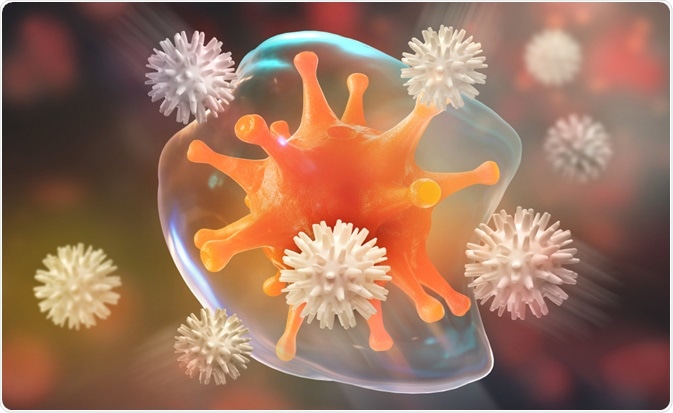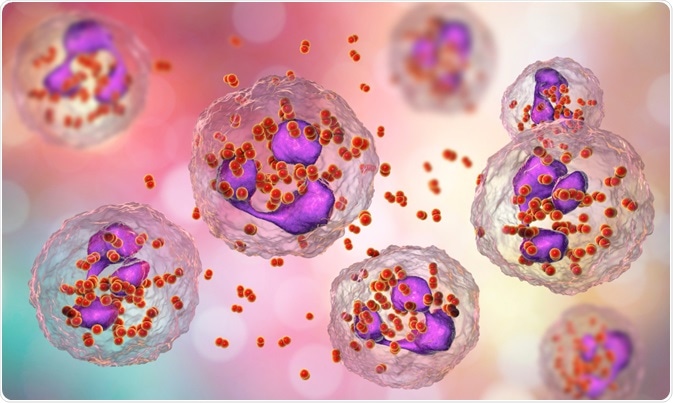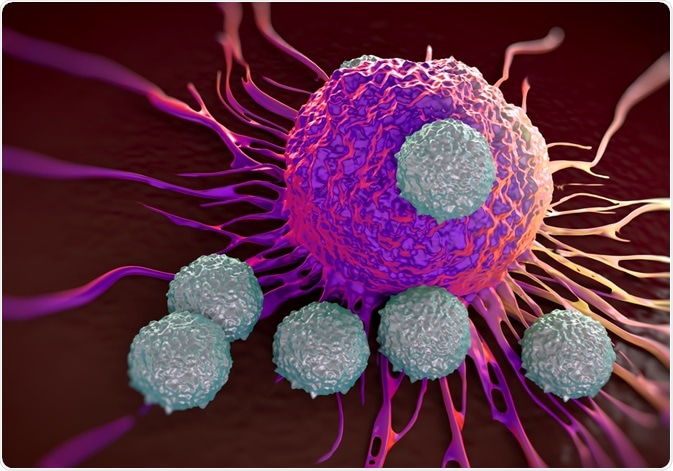The human body has three primary lines of defense to fight against foreign invaders, including viruses, bacteria, and fungi. The immune system’s three lines of defense include physical and chemical barriers, non-specific innate responses, and specific adaptive responses.
 Image Credit: Yurchanka Siarhei/Shutterstock.com
Image Credit: Yurchanka Siarhei/Shutterstock.com
What is the immune system?
The immune system is a complex network of specific immune cells and proteins that work in synergy to protect the body against foreign invaders and harmful toxic materials coming from the environment.
Foreign substances that trigger an immune response are called antigens. However, under certain circumstances, such as in autoimmune diseases, the immune system can be activated by self-antigens, leading to the destruction of the body’s cellular components.
In general, the immune system can be activated to generate two types of immune responses: nonspecific response (innate immunity) and specific adaptive response (acquired immunity).
What are the three lines of defense of the immune system?
The immune system comprises three levels of defense mechanism that a pathogen needs to cross to develop infection inside the body.
Physical barrier
The innate immune system provides the first line of defense, which is divided broadly into two categories – physical/chemical barriers and nonspecific resistance.
Physical barriers, including the skin and mucosa of the digestive and respiratory tracts, help eliminate pathogens and prevent tissue and/or blood infections. Moreover, components that are secreted by the skin or mucosa, such as sweat, saliva, tears, mucous, help provide a basic barrier against invading pathogens.
The skin is the impermeable physical/mechanical barrier that protects many pathogens from entering the body. Similarly, mucosa or mucous membranes that line the immediate internal systems help trap pathogens by producing mucous. Hairs inside the nasal cavity, as well as cerumen (earwax), also trap pathogens and environmental pollutants.
Some acidic fluids, such as gastric juice, urine, and vaginal secretions, destroy pathogens by creating low pH conditions. Also, lysozyme found in tears, sweat, and saliva acts as a vital antimicrobial agent to destroy pathogens.
 Image Credit: Kateryna Kon/Shutterstock.com
Image Credit: Kateryna Kon/Shutterstock.com
Nonspecific innate response
Pathogens that successfully cross the physical barriers are next encountered by the second line of defense. This innate immune response mostly involves immune cells and proteins to nonspecifically recognize and eliminate any pathogen that enters the body.
Phagocytosis is a crucial phenomenon of the innate immune system that utilizes a special type of immune cells called phagocytes. There are two types of phagocytes namely macrophages and neutrophils. These cells are found in the tissues and blood.
In the beginning, phagocytes recognize and bind pathogens and then use the plasma membrane to surround and engulf pathogens inside the cell. As a result, a separate internal compartment (phagosome) is generated, which subsequently fuses with another type of cellular compartment called the lysosome. The digestive enzymes present inside lysosomes finally destroy pathogens by breaking them into fragments.
Digestion of pathogens inside a phagosome produces indigestible materials and antigenic fragments; of which, indigestible materials are removed by exocytosis. However, the antigenic fragments are displayed on the surface of phagocytes, which are subsequently recognized and destroyed by cytotoxic T cells.
In addition, complement proteins are activated, which in turn recruit more white blood cells (neutrophils, eosinophils, and basophils) at the site of infection, leading to an inflammatory response (swelling, redness, pain).
Specific adaptive response
The third line defense aims at eliminating specific pathogens that have been encountered by the immune system previously (adaptive or acquired immune response). Instead of being restricted to the site of infection, the adaptive immune response occurs throughout the body.
The adaptive immune system mainly involves two types of white blood cells (lymphocytes) – B lymphocytes (B cells) and T lymphocytes (T cells). B cells are involved in antibody-mediated immune responses (humoral immunity), whereas T cells are involved in cell-mediated immune responses.
In antibody-mediated immunity, B cells are activated when they encounter a ‘known’ antigen. Activated B cells then engulf and digest the antigen, which is followed by a representation of MHC (major histocompatibility complex)-bound antigenic fragments on the B cell surface.
The combination of antigen-MHC further activates helper T cells, which in turn secrete cytokines (interleukins) to trigger the growth and maturation of antigen-presenting B cells into antibody-producing B cells (plasma cells). At this point, some B cells are transformed into memory cells to keep the immune system ready for the next attack.
Antibodies produced by the plasma cells are secreted into the bloodstream where they execute their functions in different ways. For example, by forming the antigen-antibody complex, antibodies can prevent antigens from binding host cells, leading to the prevention of infection. Antibodies also bind and mark pathogens for destruction through phagocytosis.
The antigen-antibody complex can initiate a series of signaling events to activate complement proteins, which in turn kills pathogens by rupturing their cell membrane. Complement proteins also trigger an inflammatory response, leading to the accumulation of white blood cells at the infection site.
In cell-mediated immunity, T cells are activated when they encounter antigen-presenting cells, such as B cells or dendritic cells. Activated T cells then secrete cytokines that further trigger the production and maturation of T cells.
T cells that mature into cytotoxic or killer T cells mainly destroy pathogen-infected cells, damaged cells, and cancer cells by rupturing the cell membrane. Whereas, T cells that mature into helper T cells facilitate B cells to execute antibody-mediated immune responses.
Some T cells that mature into regulatory T cells help cease the immune response and maintain the immune system homeostasis when the threat is eliminated. Also, some T cells that mature into memory T cells remember the pathogen and initiate an immediate response when the body encounters the same pathogen for the second time.

Image Credit: royaltystockphoto.com/Shutterstock.com
References
Further Reading
Last Updated: Mar 11, 2021